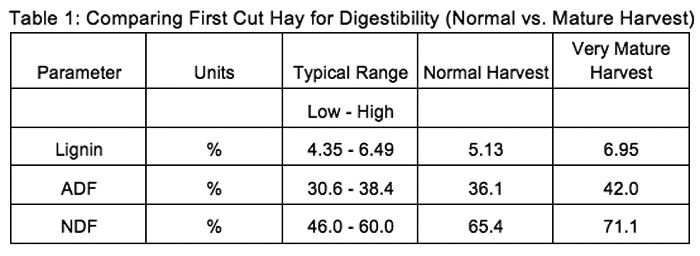2023 was a tough year for harvesting hay in Ontario.
By Sue Wilson.
My horse looks fat! But when I check his Body Condition Score, he is under 6: I can easily feel his ribs and there are little to no fat deposits along his neck, withers, shoulders, back or tail head. (By the way, there is a wonderful new tool from Equine Guelph that you can use on your phone to make it easy to check your horses’ BCS https://thehorseportal.ca/healthcare-tools/body-condition-scoring-tool/interactive-body-condition-score/ )
My horse, the palomino in the photo, has a very large hay belly this winter. But he is not obese.
It's been important for me to realize the difference and how the hay belly is caused.

2023 was a tough year for harvesting hay in Ontario. Record rainfall in June and July resulted in few consecutive days of the sunshine needed to cut, dry and bale hay. A lot of first cut hay was harvested later in the summer, when the crops were overly mature.
Digestibility of hay is affected by maturity. Hay cut when it is overly mature has more fibre and is less digestible. Hay that is too high in indigestible fibres can increase the risk of gastrointestinal disturbances and cause the infamous hay belly.
Our horses live outside on a track system with free access to shelter in a large, cozy bank barn. In winter, they are not blanketed, and they choose to be outside most of the time day and night. They are on a forage-first diet and always have access to hay in their OptiMizer slow feeders. They forage what they need, when they need it. Digesting hay fibre in their hindgut is their main source of adjustable body heat. I like to think of hay as the fuel that keeps the “furnace” going in the horses’ body. In bitter, cold weather they dial up the amount of hay to keep themselves warm.
Given the challenging hay yield last year, it was particularly important to test our hay so that we could try to make the best out of what we were able to get. Our hay was first cut, mostly grass from the same farm. About half of it was harvested at the normal time, but the other half was harvested very late in the season (late July/early August).
Comparing the digestibility of these 2 cuts, we looked at:
1. Lignin. This is the indigestible fibre in the hay.
2. ADF (Acid Detergent Fibre). This measures the least digestible fibres which includes lignin and cellulose. ADF is negatively correlated with digestibility, so the higher the number, the less the hay will be broken down inside a horse's gastrointestinal tract. It also distends the digestive tract, resulting in the hay belly.
3. NDF (Neutral Detergent Fibre). This measures all the fibre in the hay, including ADF and hemicellulose. NDF is negatively correlated with forage intake, so the higher the number, the less hay a horse will eat.
Overall, the very mature hay has very low digestibility. To make the best of it, we used it early in the season, when the horses still had some late autumn grass available. As the winter progresses, we are mixing it in each OptiMizer with two other cuts of hay that are more digestible. With this fibrous hay, we wanted to ensure the horses had plenty of water to drink, so we added a second water source, closer to their foraging area.
Hay is so vital to a horses’ diet and health. And yet it can be so variable. It is important to get hay analyzed to fully understand it and optimize feeding it. This year, it also helped me understand why my horse has such a large hay belly- it’s filled with much more fibre than usual! I know his belly will quickly melt away in the spring once he gets started on pasture. In the meantime, I have to keep telling myself that he is NOT fat, despite looking like he is.
Sue Wilson
Wishing Well Services, Ltd
info@hayoptimizer.net
Photo caption:
Whisky, the 25 year old palomino, with the big hay belly and body condition score 5.7
For more information visit https://hayoptimizer.net/


